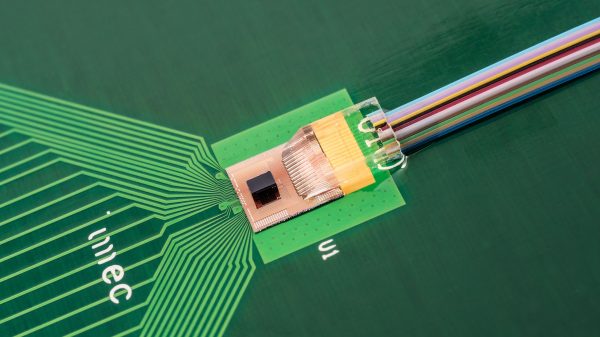This week, at the 45th European Conference on Optical Communication (ECOC), imec, a world-leading research and innovation hub in nanoelectronics and digital technologies, together with IDLab and the Photonics Research Group, both imec research labs at Ghent University, are presenting key milestone results in silicon photonics (SiPho) technology development. The demonstrated building blocks help pave the way for 400Gb/s and beyond optical links as well as for co-packaged optics in next-generation datacenter switches – key enablers for data transmission in future data centers. Highlights include a TSV-assisted, high-density (Tbps/mm2) CMOS-SiPho transceiver prototype, a low-power 106Gb/s PAM-4 SiPho transmitter, a high-speed Ge/Si avalanche photodetector, and ultra-broadband low-loss single-mode fiber couplers.
The exponential growth of the Internet and its associated applications has pushed datacenters to deploy optical interconnects with continuously increasing performance, and ever smaller power consumption and footprint. In the next few years, data center optical links will be upgraded to 400Gb/s capacity, by aggregating four 100Gb/s PAM-4 lanes per link. As a consequence, the aggregate bandwidth to be handled by a single datacenter switch will increase to 51.2Tb/s, requiring ultra-high-density SiPho transceiver technology, tightly integrated and co-packaged with the switch CMOS chip.
To help industry meeting these challenging scaling requirements, imec and its research labs at Ghent University are developing the key technology building blocks, by leveraging imec’s Si Photonics Platforms on 200mm and 300mm wafers, in combination with high-speed electronics.
Joris Van Campenhout, Program Director Optical I/O at imec commented: “Our R&D programs have delivered substantial improvements at various levels of Si Photonics technology, both at the level of process integration, individual component development as well as at the sub-assembly level. We are thrilled to share our progress with industry and academia at the ECOC conference. We look forward to continue helping the communications industry in Europe and beyond to address the key challenges in developing next-generation optical interconnect technology.”
One of the highlights that imec presents at ECOC is the first through-silicon-via (TSV) assisted hybrid FinFET CMOS/Si-photonics transceiver technology. Operating at a data rate of 40Gb/s non-return-to-zero (NRZ, single lane), this prototype combines ultra-low power consumption with impressive (1Tbps/mm2) bandwidth density, paving the way to ultra-dense co-packaged optics in future datacenter switches.
Imec and Ghent University are also presenting a 106Gb/s transmitter that uses PAM-4 as a modulation format. This 4-level modulation format has recently been adopted by industry as the modulation format of choice for 53GBd single-lane transmission over 500m. Compared to other PAM-4 transmitters, imec’s solution does not use any equalization or digital signal processing and integrates two parallel GeSi electro-absorption modulators. This results in an extremely compact and low-power (1.5pJ/b) transmitter able to transmit data over 1km single-mode fiber at 106Gb/s.
Also, imec demonstrates improved edge coupler designs, based on a hybrid Si/SiN photonic platform. Innovations to the layer stack resulted in better than -1.5dB/fiber coupling efficiency to industry-standard single mode fibers for operation in the O- and C-band. On the receive side, a high-speed Ge/Si avalanche photodetector is presented with a multiplication gain of 8 and 32GHz bandwidth. These avalanche photodetectors show great potential for improving receiver sensitivities and optical link margins at data rates of 40Gb/s and beyond.
Top Photo: TSV-assisted FinFET CMOS/Si photonics transceiver prototype.



















